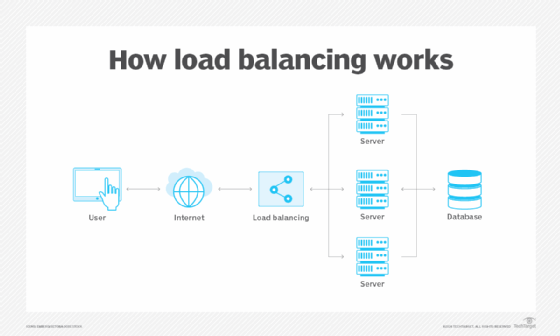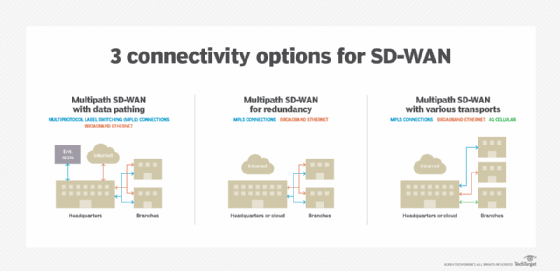
SD-WAN vs. load balancing: How are they different?
Load balancing is beneficial for network traffic distribution. SD-WAN can use load balancing for WAN connections, but it doesn't require load balancing to reap other benefits.
Load balancing and software-defined WAN have similar capabilities but are not quite interchangeable.
Load balancing is a traditional networking technique commonly used within data centers or clouds. SD-WAN is a newer technology that can use load balancing capabilities to improve WAN transport performance and reliability.
Load balancing focuses on network traffic and lowering service latency. SD-WAN, while able to use load balancing techniques, connects and centralizes different geographic locations within an organization. Both technologies can benefit a network, but organizations should not use them for the same purposes.
How load balancing works
Load balancing spreads inbound and outbound traffic across multiple paths, improving efficiency and lowering application and service latency. This practice is especially beneficial in heavy traffic situations. Organizations can run load balancing as low as the individual server level and as high up as the data center or cloud.
Many paths and duplicate application and service destinations exist for load balancing. To accommodate traffic, load balancing creates an added degree of failover. If one path or server becomes inaccessible, the other continues functioning at a reduced maximum capacity. Configuring two or more links in active/standby mode isn't considered load balancing because the traffic load isn't simultaneously shared across multiple links.
In most cases, organizations load balance within the data center or inside public or private clouds. Load balancing for applications, services or internet access does not require a WAN. However, organizations can use load balancing for WAN connections if they have SD-WAN and more than one connection per branch location.
An example of traditional load balancing is placing a load balancer in front of a series of duplicated application servers. When a user attempts to access the application, the destination IP address resides in the load balancer, not an application server. The load balancer acknowledges the end user request and transmits it to one of the application servers. Which one depends on the algorithm criteria.

How SD-WAN works
SD-WAN makes deploying and managing WAN connections easier. It centralizes configuration management, as well as network health and performance monitoring. SD-WAN provides the opportunity to add multiple links between headquarters, data centers, clouds and branch offices. SD-WAN can enable load balancing algorithms across multiple links. In doing so, the traffic load across links balances based on numerous criteria. It even provides resiliency in case of a single link failure.

SD-WAN can enable load balancing but does not require it. SD-WAN can use a single link to connect two locations and provide organizations with the benefits of centralized management and visibility. When SD-WAN combines with load balancing, it improves branch office connectivity to the applications and data needed to run local operations.
SD-WAN often uses different physical and logical transports, such as MPLS, Ethernet and 4G/5G LTE. In these cases, traffic can be load balanced across asymmetric transports, as it recognizes differences in bandwidth and latency that each provides.
Where are load balancing and SD-WAN deployed?
Traditional load balancing is designed to make the most efficient use of networking and computing resources for specific applications and services. It also shares multiple ISP access links for improved performance and reliability. Examples where load balancing is commonly deployed include the following:
- Application and database servers running in private data centers or public and private clouds.
- Firewalls and internet gateway routers.
- Multi-region application and service access.
SD-WAN deployments connect multiple geographically separated networks. Thus, SD-WAN hardware or virtual appliances can potentially be deployed at the WAN edge of the following locations:
- Corporate LAN.
- Branch office.
- Private cloud or data center.
- Public cloud.
Editor's note: This article was written originally by John Fruehe and updated by Andrew Froehlich to reflect industry changes and improve the reader experience.
Andrew Froehlich is founder of InfraMomentum, an enterprise IT research and analyst firm, and president of West Gate Networks, an IT consulting company. He has been involved in enterprise IT for more than 20 years.
John Fruehe is an independent enterprise technology analyst with more than 25 years of experience. He has specialized in enterprise networking and data center markets with a focus on product marketing.






